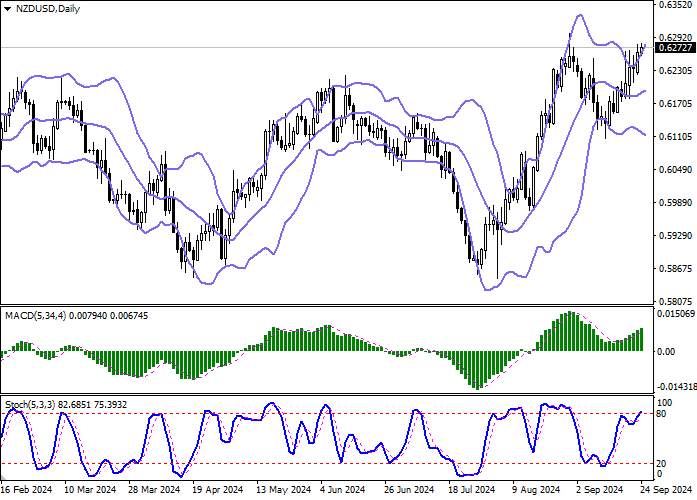Current trend
The NZD/USD pair is showing quite active growth, developing a newly strengthened "bullish" trend in the short term. The instrument is testing 0.6280 for a breakout, updating the local highs of August 29.
As before, the NZD/USD pair is supported by some weakness in the American currency, which remains under pressure after the US Federal Reserve's reduction in borrowing costs last week. The regulator adjusted the interest rate by –50 basis points at once, and also signaled in favor of two more reductions in the rate by the end of the current year. The inflation forecast for 2024 was revised from 2.6% to 2.3%, and for 2025 — from 2.3% to 2.1%. Thus, the American regulator demonstrates confidence that the growth of consumer prices is under control, which allows it to plan further easing of monetary parameters in the near future.
New Zealand's macroeconomic statistics released yesterday showed a slowdown in Exports in August from 6.09 billion dollars to 4.97 billion dollars and an acceleration in Imports from 7.10 billion dollars to 7.17 billion dollars, leading to an increase in the trade deficit from –1.016 billion dollars to –2.203 billion dollars.
On Friday, online job marketplace SEEK released its August employment report, which showed job postings were at a roughly 10-year low, pre-pandemic, while responses per posting had increased for 10 straight months. The series of filled vacancies in New Zealand fell 0.4% in the June quarter and was also revised down sharply. In turn, Stats NZ data showed a –0.2% quarter-on-quarter adjustment in real Gross Domestic Product (GDP) and a –0.5% quarter-on-quarter adjustment in GDP per capita, marking the seventh consecutive quarter of negative growth. Against this backdrop, the Reserve Bank of New Zealand (RBNZ) needs to take more aggressive steps to adjust borrowing costs at its next meetings to avoid the national economy slipping into recession.
In turn, the American currency was pressured on Monday by business activity statistics: the Services PMI in September fell from 55.7 points to 55.4 points, and the Manufacturing PMI — from 47.9 points to 47.0 points, while forecasts suggested growth to 48.5 points.
Support and resistance
On the daily chart, Bollinger Bands are gradually reversing to the ascending plane. The price range is expanding from above but it fails to conform to the development of "bullish" sentiments at the moment. MACD grows, preserving a stable buy signal (located above the signal line). Stochastic shows similar dynamics but is rapidly approaching its highs, which reflects risks of the overbought NZ dollar in the ultra-short term.
Resistance levels: 0.6280, 0.6300, 0.6330, 0.6368.
Support levels: 0.6254, 0.6221, 0.6200, 0.6177.


Trading tips
Long positions can be opened after a breakout of 0.6280 with the target of 0.6330. Stop-loss — 0.6254. Implementation time: 1-2 days.
A rebound from 0.6280 as from resistance, followed by a breakdown of 0.6254 may become a signal for opening of new short positions with the target at 0.6200. Stop-loss — 0.6280.





Hot
No comment on record. Start new comment.